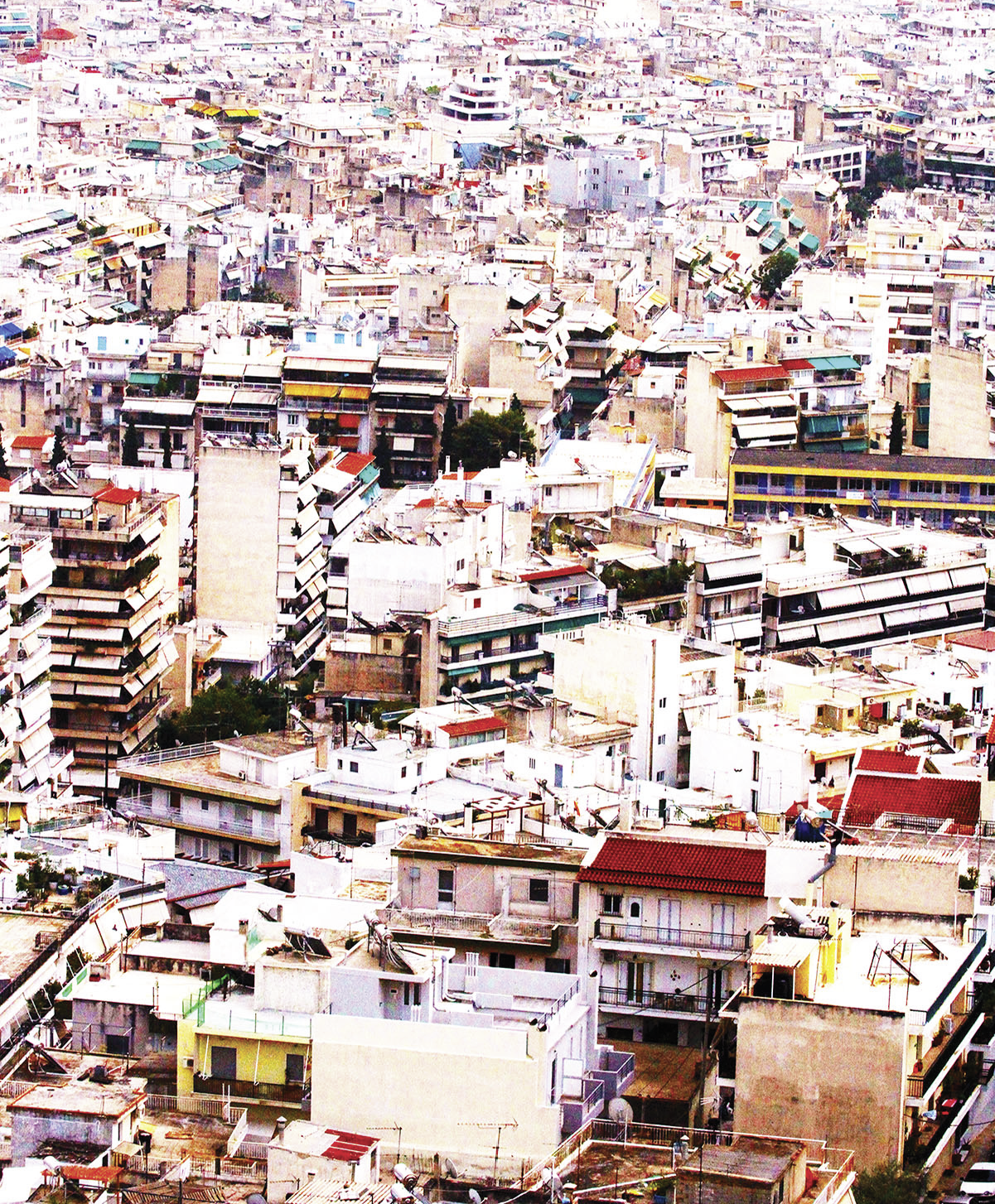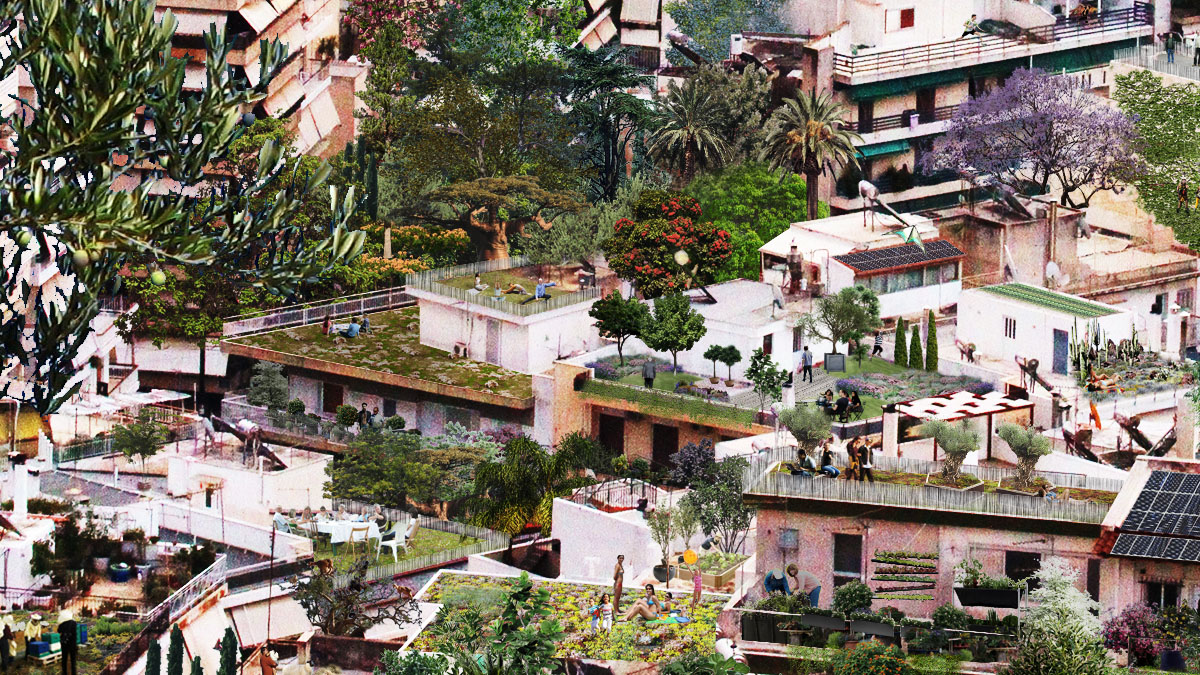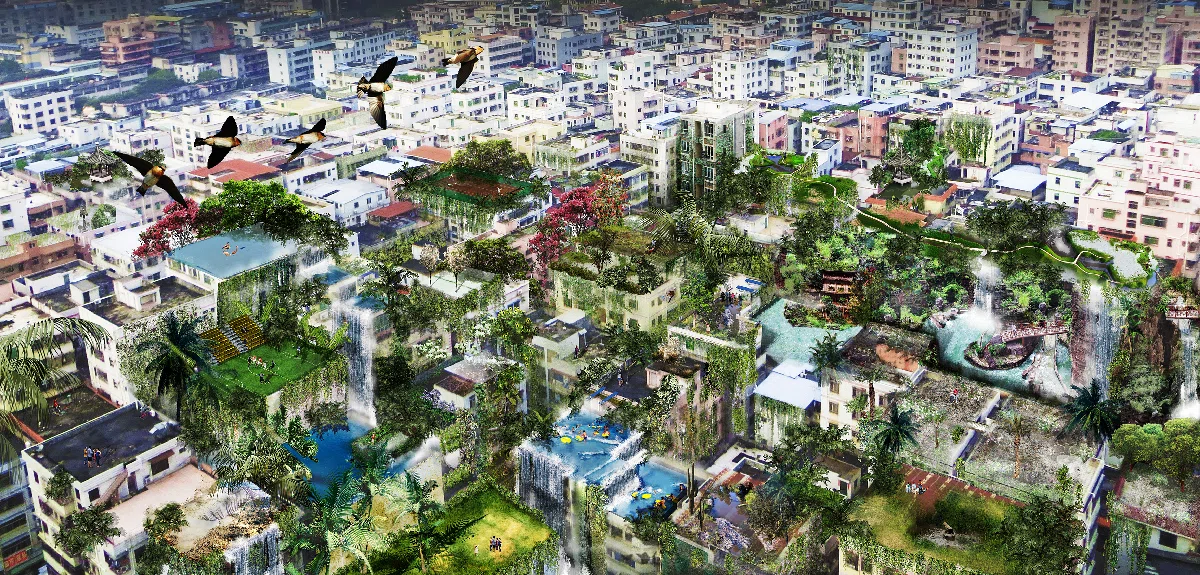With our planet getting hotter and hotter, we need to cool down our cities!
Consultancy to the Deputy Mayor of Athens for Climate Governance and Social Economy, Nikos Chrysogelos, on urban climate adaptation strategies.
Cool Down Cities focuses on issues of urban climate adaptation, such as the ventilation of the city, Sponge City principles, the planning of green corridors in the city, and the greening of (private) buildings in Athens.
By integrating climate adaptation strategies into urban planning and design, cities can become more resilient to the impacts of climate change, enhance the quality of life for their citizens, and support local biodiversity.
Therefore, urban planners, architects, and policymakers should consider these strategies when developing new projects and retrofitting existing spaces to ensure a sustainable future for our cities.
A combination of these strategies is often necessary to achieve the most substantial results, as each approach has its own set of benefits and challenges.
It is also crucial to consider the specific context of the city and the interplay between various urban elements to develop effective and sustainable solutions.
Consultancy Cool Down Cities @ Municipality of Athens, Deputy Mayor of Athens for Climate Governance and Social Economy Nikos Chrysogelos, Athens 25 August 2024

Ventilation
of
the
City
The ventilation of the city and thus its cooling and reduction of air pollution depend on air currents: on regional winds, such as the Meltemi prevailing summer wind in Greece, as well as on local breezes that are created from the local thermal conditions due to topography, vegetation and water bodies. As warm air, being lighter than cooler one, rises, this creates an air current that can result in valley wind systems, urban wind systems and coastal winds. These complex wind patterns are to be identified with the help of Wind Analysis Maps of the city.
Due to topography, there can be a valley wind system with different effects during day and night: During daytime and especially in the afternoons, the slopes exposed to the sun warm up more quickly than the valleys, creating an upward breeze. At nighttime, this phenomenon is reversed. During the night, the hilltops being more open than the valleys and radiating heat more easily, cool off quicker and the cool air being heavier moves to the lowest parts of the valleys, creating a downhill air flow.
On a smaller scale, the strong difference in temperatures in the direct surroundings of high-rise buildings can create intense air turbulences on the street level.
Due to evapotranspiration and to their much lower level of anthropogenic heat, green and forested areas are cooler than built ones during heat events. Therefore, there can be an air flow between the densely built-up city center and large open parks or loosely built-up residential areas. And during extreme winter temperatures the forested areas can be warmer, tempering the local climate.
In the combination of both abovementioned phenomena, if the green area is located lower than its surrounding, the cooler air being heavier stays there and cannot flow upwards into the city. Whereas when the green area is at a higher elevation than the surrounding city, the cooler air can stream downhill to cool its surroundings.
Also, during hot summer days the land gets heated faster than the water bodies. The air above the land is therefore warmer than above the sea, resulting in the air above land rising up and being replaced by the cooler coastal breeze. And with water bodies storing the heat longer, this phenomenon reverses at night.
Therefore, green areas connecting the surrounding landscape with the city center, the so-called ‘landscape fingers’, can significantly help mitigate the urban heat island effect. Next to open spaces, cool breezes can also flow through loosely built areas. Even though a high density of large trees has many beneficial effects (mitigating extreme heat events, air and noise pollution, enhancing biodiversity and the well-being of citizens) ventilation axes should be kept open and free of higher obstacles such as many trees (or buildings) that could block the beneficial air streams. On a smaller scale, the proportion as well as the direction in relation to the wind of buildings and of open spaces, streets and plazas can influence the wind patterns and ventilation potential.
While planning the ‘natural air-conditioning system’ of the city it is important to identify the most vulnerable areas and functions, such as schools or retirement homes. Climatope maps, indicating micro-climate, combined with activity maps help define the ventilation requirements during daytime and nighttime respectively. In the city center and office districts cooling during daytime should be prioritized, thus large trees with dense canopies preferred. On the other hand, open green areas that cool down quickly at nighttime are relevant for residential areas where night cooling is paramount.
Such ‘natural air-conditioning systems’ have been implemented in vernacular architecture for thousands of years, for example, with the patios and ponds and windcatchers or wind towers (that actually function also without wind) in traditional Persian or Arab houses.

Sponge
City
Sponge City is a term for an urban construction model for slowing down the flow of (rain) water and letting it sink. Sponge City solutions for blue-green infrastructures rely on the local topographic and soil conditions in order to detain the run-off and absorb it, the water then being naturally filtered by the soil, purified by vegetation and wetlands, retained and eventually stored to be locally reused. A Sponge City behaves like a sponge by absorbing the (rain) water, to be then given back to the urban landscape – thus making the city more flood- and drought-resilient by boosting urban absorbency.
Sponge City solutions are very relevant for addressing climate crisis challenges as they help mitigate extreme weather events such as strong precipitations and floods as well as heat waves and droughts. Slowing down the flow of rainwater is very valuable for flood prevention, reducing the danger of flooding of streets and neighboring buildings as well as of sewer overflow and its negative effects. Capturing the rainfall can also reduce the irrigation needs, recharge the groundwater as well as feed the irrigation systems of urban green areas and water features, Thus, Sponge City is also a strategy for addressing the problems caused by drought and water scarcity. As a decentralized rainwater harvesting, Sponge City solutions foster green urban spaces, mitigating urban heat, boosting urban eco-systems and enriching biodiversity and supporting human well-being and health.
Sponge City elements can be manifold. Among them are green and water retention roofs and green facades, porous roads and pavements, swales, rain gardens and retention areas, constructed wetlands, green corridors and parks – including grey water recycling at the building block level.
The Sponge City concept was proposed by Chinese researchers in early 2000 and accepted by the Chinese government as nationwide urban construction policy in 2014. European cities are adopting the Sponge City approach, using a series of different implementation methods:
Berlin in order to transform into a Sponge City, established in 2018, as a collaboration of the Federal State of Berlin and the “Berliner Wasserbetriebe” (Berlin Waterworks), the “Berliner Regenasserangentur” (Berlin Rainwater Agency) that is dedicated to supporting the administration, the planners, and the citizens in the implementation of decentralized solutions in rainwater management; see selected projects: Berlin Rainwater Agency
Copenhagen also committed to transform into a Sponge City with its “Cloudburst Management Plan” developed in 2012: Cloudburst Management Plan
The “Association suisse des professionnels de la protection des eaux” (“Swiss Association of Water Protection Professionals) established in 2022 the working group “Ville éponge Suisse”: Swiss Sponge City
The “Agence Parisienne du Climat” (Paris Climate Agency:) that supports the implementation of the Climate Plans of the City of Paris and of the Greater Paris Metropolis is promoting Sponge City solutions in 2024: Paris Sponge City
Nevertheless, the Sponge City approach is nothing but new as it is an adaptation of old peasant irrigation systems to urban environments, to be found in traditional landscape construction principles worldwide. For example, the pre-Incan 1,400-year-old “Amuna”-technique (still in use in Huamantanga, Andes, Peru) captures rainfall in shallow canals made of rock, to transport the water to places of permeable soil where it will be absorbed into the ground. In the Greek context, the traditional terraces the Aegean landscapes can be considered as a vernacular Sponge (Landscape) solution avant la lettre. In the same way, also contemporary Sponge City solutions adapt to the very specific local conditions and are therefore manifold.

Green
Corridors
Connecting the existing fragmented and isolated urban green areas via green corridors – with the goal of linking these areas to the peri-urban nature – is of great importance for enhancing the livability of urban environments. Such green urban networks of linear natural infrastructures with trees and other plants provide services to both, to urban populations as well as to urban nature.
Green corridors improve the accessibility of green areas. They also function as sustainable mobility networks for the city in general, supporting the walkability and cyclability and the use of public transport. This helps reduce motorized traffic and the resulting energy consumption, emissions, pollution and heat. By promoting physical activity such as walking and cycling, they promote healthier lifestyles. Connected green spaces also enhance possible interaction of different social groups, strengthening social cohesion.
Providing a natural network by connecting blue-green infrastructures in the city also helps boost urban biodiversity. Green corridors can function as continuous habitats for local flora and fauna (pollinators, birds and other animals). This is of great importance for the ecological balance and the self-regulation of ecosystems and thus for their resilience. Next to public green areas and green streets also smaller green elements such as private gardens, green roofs and terraces and green walls can function as ‘stepping stones’ for fauna and flora.
As elements of a network of blue-green infrastructures, green corridors help mitigate extreme weather events such as heat waves and the negative effects caused by strong precipitations, providing the benefits of urban green spaces.
It is therefore important to consider green corridors while conceptualizing urban master plans and formulating urban development strategies. The planning of green corridors needs to consider existing urban green areas, blue-green infrastructures and peri-urban nature spaces as well as mobility networks and community, commercial and transport hubs. Similar to other urban public spaces, green corridors should be multipurpose and multifunctional, with different activities, such as environmental, sports, cultural, social and other, coexisting alongside in the same space.
It would be preferable if green corridors are large enough to accommodate people as well as wildlife. Audits of existing local fauna and flora are necessary and methodologies such Animal Aided Design are helpful for specifying the features of the green corridors, so they can host habitats for the local fauna. Green corridors should also be designed following Sponge City principles (see above). And when the continuity of the corridor is not possible, smaller green spaces (see above) scan help bridge the gaps of the network.
The project of 550 km of “20 Green Walks in Berlin “ (“20 Grüne Hauptwege Berlin”) started in 2004 by the Berlin Senate, involving civil society as well as NGOs such as the German Federation for the Environment and Nature Conservation (BUND) and the organization representing pedestrian interests (FUSS e.V.) that walked the routes, identifying the gaps and suggesting ‘temporary detours’: 20 Green Walks in Berlin
Seoul dismantled an elevated highway and revived a previously covered stream, creating the “Cheonggyecheon River Corridor” as a linear waterfront park in 2005: Cheonggyecheon River Corridor
Montreal’s “Green Alleys Network”, a participative project revitalizing an older walking infrastructure, such as alleyways, creating a green walking network of 346 green alleys in 2016: Green Alleys Network
Medellín in Colombia started its “Corredores Verdes” (“Green Corridors”) program in 2016, developing 30 green corridors alongside with 124 parks: Medellín Green Corridors
Green
Buildings
The city of Athens has very little space for urban green with most streets being narrow and occupied by cars – and having unfortunately to stay so until the establishment of a well-functioning public transport alternative. A short-term strategy aiming at greening the city should therefore also focus on integrating green into the existing buildings and private built environment.
This could be achieved by integrating green into the city through the existing structure of the block of flats. The “Polykatoikies” (πολυκατοικίες is the Greek term for apartment buildings) with their balconies, horizontal roofs and inner courtyards (ακάλυπτοι) can provide such an infrastructure for greening.
Such interventions can function as blue-green infrastructures that mitigate heat island effects and air and noise pollution, retaine the water and slow down its flow that burdens the sewer during strong precipitations (Sponge City effect) and enhance biodiversity. Beyond a high aesthetic value, greening the buildings can also provide insulation, thus reducing the cooling and heating costs in the summers and winters respectively. As a participative project, the communal planted roofs, terraces and courtyards can serve as a communication spaces, strengthening a more public and communicative character for the block of flats.
The project “Poly Garden City” by Hybrid Space Lab aims to raise awareness of climate change adaptation and, in particular, of the participatory dimension of climate adaptation by promoting the integration of green in the Athens’ built environment: Athens Poly Garden City.
Poly Garden City was for example published in the leading Greek newspaper Kathimerini: Poly Garden City @ Kathimirini in English and in the Greek lifestyle magazine LIFO: Poly Garden City @ Lifo in Greek.
Many cities around the world are creating incentives for the greening of (private) buildings, for example: In Ernaculam and Thiruvananthapuram in Kerala the government promotes and subsidizes vertical garden structures for balconies and terraces, encouraging urban farming by citizens: Indian Vertical Garden Structures
The funding program “GründachPLUS” (“GreenroofPLUS”) of the Berlin Senate Department for Urban Mobility, Transport, Climate Action and the Environment subsidizes green roofs and facades: GreenroofPLUS
The Municipality of Rotterdam is promoting and subsidizing (European Commission program LIFE@Urban Roofs) the multifunctional use of roofs for water retention, sustainable energy production, greening and biodiversity and rooftop terraces as social and residential spaces: Rotterdam Urban Roofs
Amsterdam and Rotterdam went into a ‘tile-popping’ competition, encouraging citizens to remove impermeable surfaces in their courtyards and gardens, in a program focusing on public education and participatory climate adaptation: Dutch Tile-Popping Competition
related PROJECTS
related PRESS